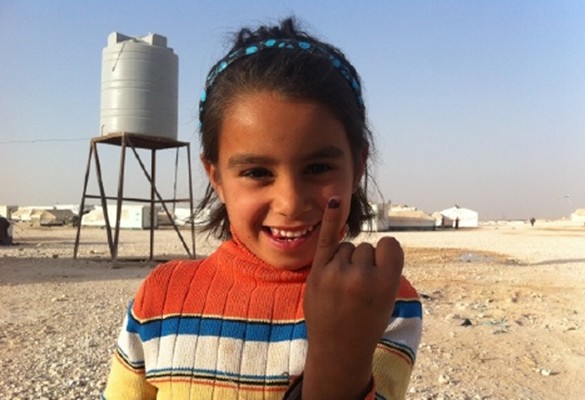One Year Since the Last Case of Polio In Syria
Despite civil war and mass population displacement, incredible gains have been made against the polio outbreak in the Middle East.

January 21 will mark a year since the last case of polio was reported in Syria. This significant milestone is thanks to a tremendous effort by all those involved in outbreak response since the first case was confirmed in October 2013 and was followed by a series of intense vaccination activities starting that same month.
Before this outbreak, Syria had not seen an endemic case of wild poliovirus since 1999. The civil war was devastating to public health in the country, and levels of immunization fell from 99% coverage to 52%. Spreading along with the conflict into Iraq, the polio virus had paralysed 36 children in Syria and two in Iraq by the end of April 2014.
A year with no reported cases in Syria, and 9 months since a case in Iraq, is a remarkable achievement that has drawn on the commitment of the governments of the region, health actors, and the commitment of parents to get the vaccines for their children. Chris Maher, Manager for Polio Eradication and Emergencies in the Middle East for the World Health Organization (WHO), commends the support that the outbreak response received, despite the challenges of operating within a severely disrupted public health system. Local authorities were very supportive, and the strong culture of the population seeking out immunization services increased the uptake of the vaccine.
Following an outbreak, mass immunization campaigns are the first tool used by health services to stop it in its tracks. With several years since the last mass campaigns, international support was needed in order to enable governments and health actors to rapidly coordinate large scale campaigns, not only in infected countries but in the surrounding countries. The mass displacement of people from and within Syria and Iraq meant that a coordinated regional response was crucial to efforts. Lebanon saw an influx of refugees that was equivalent to around a quarter of its national population, requiring a huge scale-up in immunization capacity. Alongside campaigns and the training of health workers, community engagement increasingly became a challenge due to population movements, as population figures from before the civil war were no longer accurate. This made developing a population-appropriate vaccine delivery service very difficult.
Despite these major challenges, the outbreak seems to have been brought under control. In the face of the destruction of infrastructure, both physical and human, a year with no cases in Syria is an opportunity to reflect on the incredible joint efforts that have been made to end the outbreak.
Maintaining the gains in Syria and Iraq remain of paramount importance. While polio continues to circulate in Pakistan and Afghanistan, children everywhere – especially in countries with social and political ties to this reservoir of the virus – remain at risk of paralysis caused by polio.












